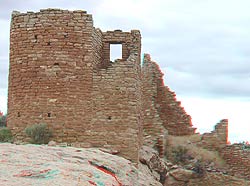
Hovenweep is a Ute word meaning “deserted valley,” an apt name for these mesas and canyons north of the San Juan River. Here lies evidence of a once vast “neighborhood” of Ancient Puebloan Culture (the term anthropologists have chosen to replace the politically-incorrect “Anasazi”), one of many in the Four Corners area of Arizona, Utah, New Mexico and Colorado. In fact, Hovenweep ruins are situated in both Utah and Colorado.
Though no one can ever know for sure, a popular theory puts forward the idea that severe droughts in the 10th and 11th centuries challenged the Ancient Puebloans ability to survive in the area. Other theories say it was war between tribes that forced the APCs to the south forever.
While the area today looks quite dry and desolate, the ruins of multifamily dwellings and lookout towers clearly indicate a once thriving community of farmers and hunter/gatherers. Hovenweep is made up of six groups of ruins comprised of square, oval, circular and D-shaped structures: the Square Tower Ruins, best-reserved and most impressive of the Utah ruins; Cajon Ruins in Utah; and Holly Ruins, Hackberry Canyon, Cutthroat Castle and Goodman Point Ruins located in the same area, but in Colorado.
Square Tower, home to the monument’s headquarters, is relatively easy to locate but the remaining ruins will take some effort. A year-round ranger station and campground located at Square Tower provides directions to the other sites.
Hovenweep can be reached from two entrance points in Colorado: the Pleasant View turnoff 18 miles north of Cortez on Highway 191; or the McElmo Canyon Road off Highway 160 west of Cortez. To approach from Utah exit Highway 163 onto SR 262, a cutoff located about midway between the towns of Blanding and Bluff, follow the road 14 miles to the Hatch Trading Post and then continue on 16 miles more to Square Tower. Be advised that all roads leading to Hovenweep are dirt roads, and bad weather can leave them muddy and impassable. Please call ahead.
Hovenweep National Monument – 970.529.4461





